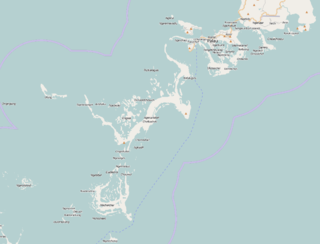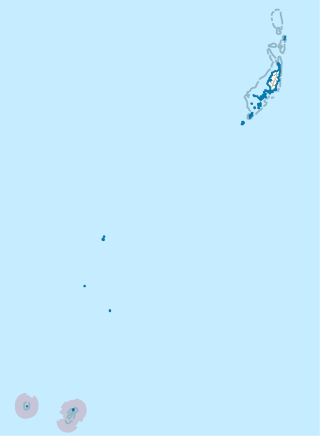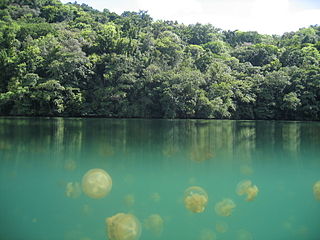
The Republic of Palau consists of eight principal islands and more than 250 smaller ones lying roughly 500 miles southeast of the Philippines, in Oceania. The islands of Palau constitute the westernmost part of the Caroline Islands chain. The country includes the World War II battleground of Peleliu and world-famous rock islands. The total land area is 459 km2 (177 sq mi). It has the 42nd largest Exclusive Economic Zone of 603,978 km2 (233,197 sq mi).

The Rock Islands of Palau, also called Chelbacheb, are a collection of several hundred small limestone or coral uprises in the Southern Lagoon of Palau between Koror and Peleliu, now an incorporated part of Koror State. There are between 250 and 300 islands in the group according to different sources, with an aggregate area of 42 square kilometers (16 sq mi) and a maximum height of 207 meters (679 ft). The islands were declared a UNESCO World Heritage Site in 2012.
The purple sulfur bacteria (PSB) are part of a group of Pseudomonadota capable of photosynthesis, collectively referred to as purple bacteria. They are anaerobic or microaerophilic, and are often found in stratified water environments including hot springs, stagnant water bodies, as well as microbial mats in intertidal zones. Unlike plants, algae, and cyanobacteria, purple sulfur bacteria do not use water as their reducing agent, and therefore do not produce oxygen. Instead, they can use sulfur in the form of sulfide, or thiosulfate (as well, some species can use H2, Fe2+, or NO2−) as the electron donor in their photosynthetic pathways. The sulfur is oxidized to produce granules of elemental sulfur. This, in turn, may be oxidized to form sulfuric acid.

A meromictic lake is a lake which has layers of water that do not intermix. In ordinary, holomictic lakes, at least once each year, there is a physical mixing of the surface and the deep waters.

Tobi, or Hatohobei (Tobian), is the southernmost of Palau's sixteen states, consisting of Tobi Island and Helen Reef. The total land area is about 0.88 km². The population was 25 in 2015. Tobian, English, and Sonsorolese are the official languages of Hatohobei State.

Jellyfish Lake is a marine lake located on Eil Malk island in Palau. Eil Malk is a part of the Rock Islands, a group of small, rocky, mostly uninhabited islands in Palau's Southern Lagoon, between Koror and Peleliu. There are about 70 other marine lakes located throughout the Rock Islands. Millions of golden jellyfish migrate horizontally across the lake daily.
Salvatnet is a lake in Namsos Municipality in Trøndelag county, Norway. With its deepest depth of 482 metres (1,581 ft), it is Norway's and Europe's second-deepest lake, after Hornindalsvatnet. Alternate sources give the depth as either 464 metres (1,522 ft) or 482 metres (1,581 ft) at the deepest point. The lake sits close to the Norwegian Sea, about 9 metres (30 ft) above sea level at the surface and reaches to a depth of 473 metres (1,552 ft) below sea level. It is a large lake with an area of 44.96 square kilometres (17.36 sq mi), a volume of 6.97 cubic kilometres (1.67 cu mi), and a shoreline that is 105.61 kilometres (65.62 mi) around.
Kakaban island is part of the Derawan Islands, East Kalimantan, Indonesia.

The spotted jelly, lagoon jelly, golden medusa, or Papuan jellyfish, is a species of jellyfish from the Indo-Pacific oceans. Like corals, sea anemones, and other sea jellies, it belongs to the phylum Cnidaria. Mastigias papua is one of the numerous marine animals living in symbiosis with zooxanthellae, a photosynthetic alga.

Mastigias is a genus of true jellyfish in the family Mastigiidae. It contains seven described species. Members of this genus are found widely in coastal regions of the Indo-Pacific, including saline lakes of Palau, but there are also records from the West Atlantic at Florida and Puerto Rico. The West Atlantic records are most likely the result of accidental introductions by humans.
A chemocline is a type of cline, a layer of fluid with different properties, characterized by a strong, vertical chemistry gradient within a body of water. In bodies of water where chemoclines occur, the cline separates the upper and lower layers, resulting in different properties for those layers. The lower layer shows a change in the concentration of dissolved gases and solids compared to the upper layer.

Eil Malk or Mecherchar is the main island of the Mecherchar Islands, an island group of Palau in the Pacific Ocean. In a more narrow sense, just the southeastern peninsula of Mecherchar is called Eil Malk.
Goby Lake is a marine lake located on Koror island in Palau. There are about 70 other marine lakes located throughout the Rock Islands and Koror. Goby Lake is notable for endemic subspecies of golden jellyfish and is one of five marine lakes in Palau used for several scientific researches in evolutionary biology the other lakes being Jellyfish Lake, Clear Lake (Palau), Uet era Ngermeuangel, Uet era Ongael.
Uet era Ngermeuangel is a marine lake located on Koror island in Palau. There are about 70 other marine lakes located throughout the Rock Islands and Koror. Uet era Ngermeuangel is notable for endemic subspecies of golden jellyfish and is one of five marine lakes in Palau used for several scientific researches in evolutionary biology the other lakes being Jellyfish Lake, Clear Lake (Palau), Goby Lake, Uet era Ongael.
Uet era Ongael is a marine lake located on Ongael Island, Koror, in Palau. There are about 70 other marine lakes located throughout the Rock Islands and Koror. Uet era Ongael is notable for endemic subspecies of golden jellyfish and is one of five marine lakes in Palau used for several scientific researches in evolutionary biology, the other lakes being Jellyfish Lake, Clear Lake, Uet era Ngermeuangel and Goby Lake.

Ulong is a major island and channel of western Palau. It is sometimes called Aulong and originally written Oroolong in English. Ulong is regarded by many as one of the best drift dives in the world.
Ongael Island is an island in Koror State, Palau. It is the location of the famous Ongael Lake.

The golden jellyfish is a subspecies of spotted jellyfish that inhabits Jellyfish Lake on Eil Malk island in Palau in the western Pacific Ocean. Like the nominate subspecies, it derives part of its nutrition from symbiotic algae (Zooxanthellae) that live in their tissues and part of their nutrition from captured zooplankton.
Deprez Basin is a nearly circular basin on the Ingrid Christensen Coast of Princess Elizabeth Land in East Antarctica.
An anchialine system is a landlocked body of water with a subterranean connection to the ocean. Depending on its formation, these systems can exist in one of two primary forms: pools or caves. The primary differentiating characteristics between pools and caves is the availability of light; cave systems are generally aphotic while pools are euphotic. The difference in light availability has a large influence on the biology of a given system. Anchialine systems are a feature of coastal aquifers which are density stratified, with water near the surface being fresh or brackish, and saline water intruding from the coast at depth. Depending on the site, it is sometimes possible to access the deeper saline water directly in the anchialine pool, or sometimes it may be accessible by cave diving.










